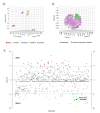The Roots of Deguelia nitidula as a Natural Antibacterial Source against Staphylococcus aureus Strains
- PMID: 36355166
- PMCID: PMC9696647
- DOI: 10.3390/metabo12111083
The Roots of Deguelia nitidula as a Natural Antibacterial Source against Staphylococcus aureus Strains
Abstract
Deguelia nitidula (Benth.) A.M.G.Azevedo & R.A.Camargo (Fabaceae) is an herbaceous plant distributed in the Brazilian Amazon, and it is called "raiz do sol" (sun roots). On Marajó Island, quilombola communities use its prepared roots to treat skin diseases commonly caused by fungi, viruses, and bacteria. Thus, in this study, the extract, and its fractions from D. nitidula roots were used to perform in vitro cytotoxic and antibacterial assays against Staphylococcus aureus strains. Thereafter, liquid chromatography-mass spectrometry (LC-MS) was used for the metabolite annotation process. The ethanolic extract of D. nitidula roots show significant bactericidal activity against S. aureus with IC50 82 μg.mL-1 and a selectivity index (SI) of 21.35. Furthermore, the SREFr2 and SREFr3 fractions show a potent bactericidal activity, i.e., MIC of 46.8 μg.mL-1 for both, and MBC of 375 and 93.7 μg.mL-1, respectively. As showcased, SREFr3 shows safe and effective antibacterial activity mainly in respect to the excellent selectivity index (SI = 82.06). On the other hand, SREFr2 shows low selectivity (SI = 6.8), which characterizes it as not safe for therapeutic use. Otherwise, due to a limited amount of reference MS2 spectra in public libraries, up to now, it was not possible to perform a complete metabolite annotation. Despite that, our antibacterial results for SREFr3 and correlated substructures of amino acid derivatives show that the roots of D. nitidula are a natural source of specialized metabolites, which can be isolated in the future, and then used as a support for further bio-guided research, as well as natural drug development.
Keywords: Staphylococcus aureus; amino acid derivative; antibacterial activity; liquid chromatography–mass spectrometry.
Conflict of interest statement
We declare no current or potential conflict of interest related to this article.
Figures




Similar articles
-
Cleistochlamys kirkii chemical constituents: Antibacterial activity and synergistic effects against resistant Staphylococcus aureus strains.J Ethnopharmacol. 2016 Feb 3;178:180-7. doi: 10.1016/j.jep.2015.12.009. Epub 2015 Dec 8. J Ethnopharmacol. 2016. PMID: 26674158
-
Antibacterial and antibiofilm activities of Mayan medicinal plants against Methicillin-susceptible and -resistant strains of Staphylococcus aureus.J Ethnopharmacol. 2021 Oct 28;279:114369. doi: 10.1016/j.jep.2021.114369. Epub 2021 Jun 26. J Ethnopharmacol. 2021. PMID: 34186100
-
The anti-Staphylococcus aureus activity of the phenanthrene fraction from fibrous roots of Bletilla striata.BMC Complement Altern Med. 2016 Nov 29;16(1):491. doi: 10.1186/s12906-016-1488-z. BMC Complement Altern Med. 2016. PMID: 27899152 Free PMC article.
-
Pristimerin isolated from Salacia crassifolia (Mart. Ex. Schult.) G. Don. (Celastraceae) roots as a potential antibacterial agent against Staphylococcus aureus.J Ethnopharmacol. 2021 Feb 10;266:113423. doi: 10.1016/j.jep.2020.113423. Epub 2020 Sep 29. J Ethnopharmacol. 2021. PMID: 33007390
-
Antileshimania, anti-Trypanosoma cruzi and antimicrobial activities of scandenin and 4'-O-methylderrone from Deguelia costata.Nat Prod Res. 2023 Aug-Sep;37(17):2951-2956. doi: 10.1080/14786419.2022.2140336. Epub 2022 Oct 29. Nat Prod Res. 2023. PMID: 36308292
Cited by
-
Metabolomic Strategies to Improve Chemical Information from OSMAC Studies of Endophytic Fungi.Metabolites. 2023 Feb 5;13(2):236. doi: 10.3390/metabo13020236. Metabolites. 2023. PMID: 36837855 Free PMC article.
References
-
- WHO Guidelines on Safety Monitoring of Herbal Medicines in Pharmacovigilance Systems. World Health Organization; Geneva, Switzerland: 2004.
Grants and funding
LinkOut - more resources
Full Text Sources
Research Materials

